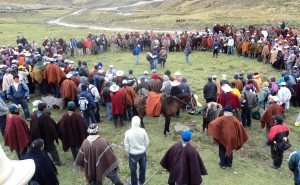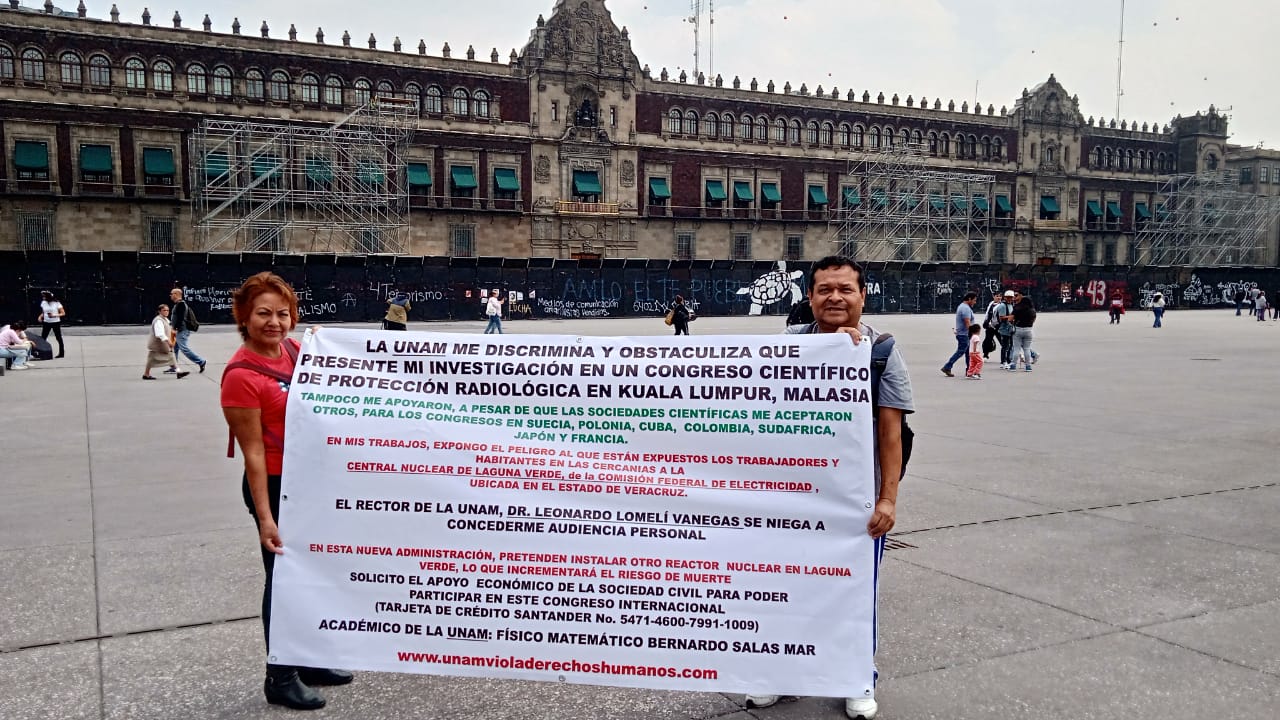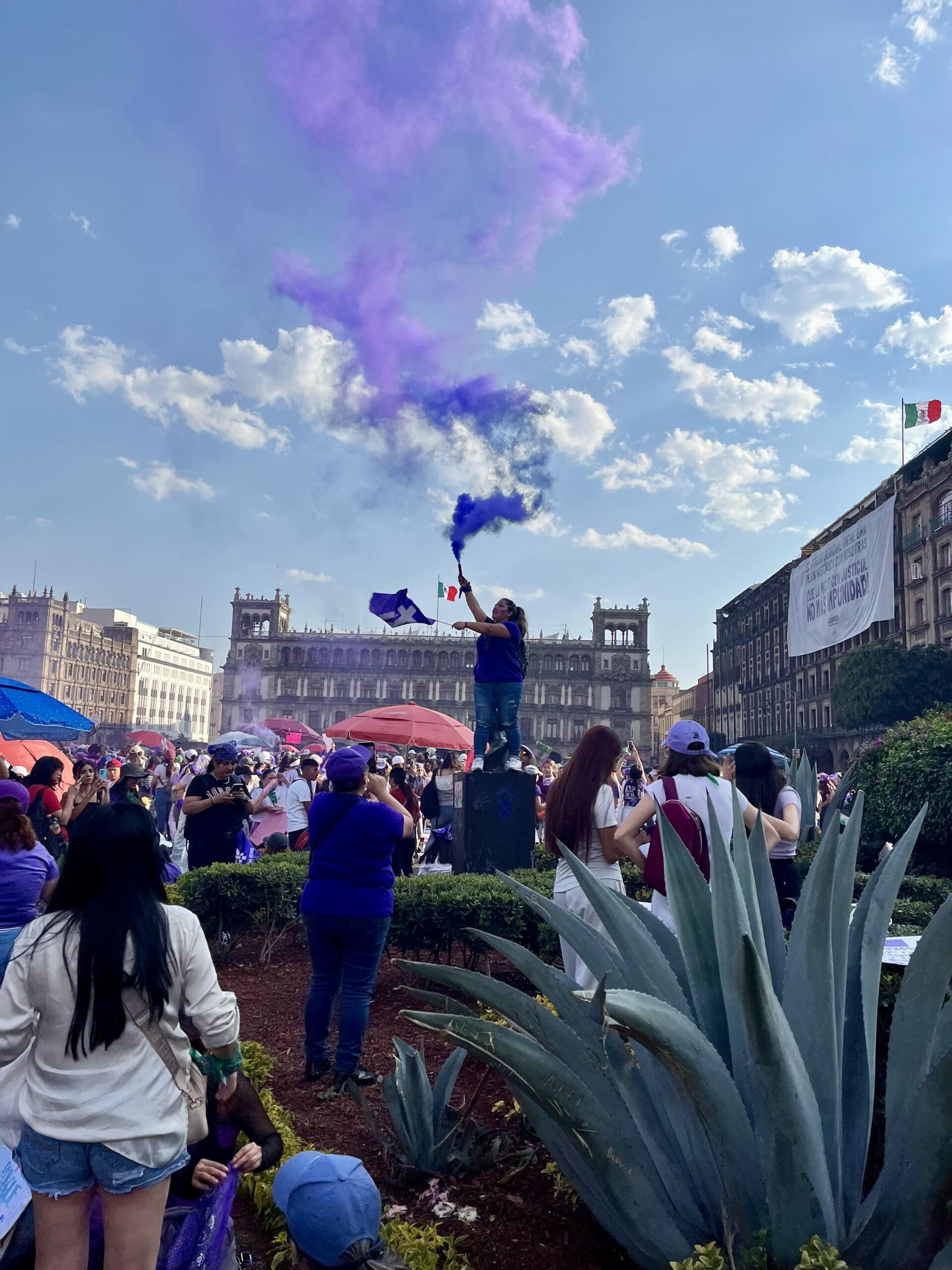 When states act to facilitate the business of multinationals and leave communities unprotected, as with mining, those communities have no choice but to defend themselves by their own means–through self-defense organizations, mobilization of affected communities, or the creation of new ways to prevent dispossession.
When states act to facilitate the business of multinationals and leave communities unprotected, as with mining, those communities have no choice but to defend themselves by their own means–through self-defense organizations, mobilization of affected communities, or the creation of new ways to prevent dispossession.
Peru and Colombia are experiencing this situation today. Resistance to mining in the Andean region shows great vitality as in the opposition to the Conga gold mining project in northern Peru and in some regions of the Colombian Cauca. In both cases, local populations have managed to slow or reverse mining, always thanks to direct community action.
In Peru, Ollanta Humala’s government approved a package of measures to facilitate foreign investment. Even the United Nations thinks it could affect the environment. A letter from the UN’s Peruvian office to the chancellor stated “legitimate concern, on the part of the United Nations system, over the impact that the new economic measures might entail.”[1]The package of measures approved on July 12 is questioned for “cuts to the functions of the Environmental Evaluation and Supervision Agency (Organismo de Evaluación y Fiscalización Ambiental, OEFA), the specialized technical agency ascribed to the Ministry of Environment (Ministerio del Ambiente, MINAM).”[2]
The relaxation of the environmental control norms foreshadows the fact that the OEFA will only be able to issue sanctions in exceptional cases for three years. And whenever it does, it will have to appeal for corrective measures without imposing fines. If corrective measures are not met, the OEFA may impose fines, but only for 50% of current amounts. It is thought that this repression of environmental control “opens doors to the impunity of irresponsible industry.”[3]
The latest report from the Observatory of Mining Conflicts in Peru (Observatorio de Conflictos Mineros en el Perú) concludes: “This package of legislative reforms reminds us of the legislative decrees that led to the tragic events of Bagua,”[4]referring to the June 5, 2009, massacre in the Amazon in which over 100 people were killed.[5]The report adds that the “package, in order to improve and build investor confidence, openly removes Ministry of Environment powers over the creation of protected areas, the issue of land use systems, ecologically economic zones, ceilings and limits, and environmental quality standards.”[6]And it concludes: “A government like this, that destroys what little there was in terms of environmental institutions, has no moral authority for becoming the host of the COP 20 event.”
Indeed, the reduction of environmental legislation in order to attract investment is happening the same year Peru will host the UN Convention on Climate Change’s Conference of the Parties (COP 20), in Lima, Dec. 1-23. Over 100 international civil society organizations involved in the COP 20 process sent a letter to the [Peruvian] government, stating that the measures to promote investment “constitute a serious setback for Peru in the environmental realm.”[7]
In the face of the stable and ongoing advance of mining megaprojects, communities know they have no way to defend themselves other than activating old forms of self defense, something that has been happening in much of Latin America. In Peru, resistance to mining has a name: campesino patrols.
From campesino patrols to lagoon guardians
Campesino patrols emerged in the late 1970s in northern Peru, in response to the inability or unwillingness of the Peruvian state to curb the increase in cattle theft. They were groups of campesinos that roamed the community territory, doing collective surveillance by night. The campesino patrols reinvented collective ancestral practices. “At the beginning, the patrols captured thieves and turned them over to the police, but on seeing that this did not result in effective punishment, they began to organize their own justice system, managed collectively by the assembly.”[8] For the patrols, justice consists in the educational character of punishment (which could be whipping) and reconciliation with the community.
Within a few years, the patrols spread throughout the north, gaining enormous status, because they brought cattle rustling under control and later stopped the entry of the Shining Path. The campesino patrols became a form of popular power with relative autonomy from the state. In addition to surveillance and justice, community members took over local development projects, inspiring a variety of political practices.
With the advance of neoliberalism and the mining industry’s powerful entrance into campesino territories, the campesino patrols assumed responsibility for territorial defense and care of the commons – especially in Piura and Cajamarca against projects like Conga. They are not only slowing the projects down, but also driving new forms of struggle forward.
Rapahel Hoetmer notes that in “neighborhood consultations on mining in Ayabaca and Huancabamba in Piura, the patrols not only took care of security and order during the referendum. They also participated in the organization and prior consultation and background information.”[9]They not only held protests, but installed gates in order to regulate access to communal land up and set up camps to guard lagoons. [These] began to be called “guardians of the lagoons,” installed permanently, rotating over the Andean highlands since October 2012.
“The campesino patrols,” Hoetmer continues, “are a regulatory and disciplinary institution of everyday life, with extraordinary influence in the northern part of the country, [a region] that has been criticized for its patriarchal and conservative character.”[10] Women’s participation is growing – with the creation of women’s patrols – even becoming one of the principal protagonists in territorial defense.
Magdiel Carrión, a member of Ayabaca’s campesino patrols, explains the different roles: “In the community, both men and women are part of the patrols. It’s not obligatory for women; they will choose if they want to be part or not. However, that committees of women’s patrols exist is obligatory. The only thing they don’t do is the night service.”[11] A patrol is formed in each village, whose members rotate. Local territorial organization is coordinated at the district and provincial level, as well as at the national scale.
The XI Congress of Cajamarca Campesino Patrols took place in January, with 2,045 delegates from 13 provinces. Among the approved agreements figure: a regional strike against the Conga megaproject, the rejection of the use of NGOs in community struggles, and an understanding “that the fight against Conga is of the community and not of any party.”[12]Carrión explains that the fight against mining requires coordination with other political actors, but warns that “we cannot allow the struggles to be capitalized on by partisan interests. That’s a big problem, for me, even bigger than most internal community problems.”[13]
Over the years, the campesino patrols have gained in maturity, and are no longer divided into political bands as it was in the early years. Community is their principal referent. Defending territory is their objective. Now the “Lagoon Guardians,” they work to become a national reference point for the defense of life, health and economic security based on community justice.
Indigenous Guard, defending territory
In some parts of northern Cauca in Colombia, [communities] have succeeded in driving the mining industry out, seizing the machinery, and filling in the tunnels, thanks to the communal decision executed under the protection of the Indigenous Guard. This is what happened in the Munchique Los Tigres reserve, near the town of Santander de Quilichao. On March 14, 2013, a “territorial control” minga (communal work) was set up to combat artisanal mining in the area. Hundreds of community members from Munchique and Canoas reserves – in the Andean foothills –ensured compliance with a collective decision, summarized in the slogan “No to mining.”[14]
The problem is that multinationals and large machinery arrive behind artisanal mining. Contamination by cyanide and mercury appears in the rivers and streams, and communities become divided and sick, as the authorities say.
The March action was decided on Jan. 7 in a large community meeting. It came after long debates, because some people in the community had been digging tunnels and using machinery to extract gold. The community found the damage and gave the miners a two-month deadline for filling in the mining tunnels and selling the mills.
The story on the Tejido de Comunicación page of the Associations of Indigenous Councils of Northern Cauca speaks for itself: “More than 1,200 people, working in two commissions, climbed the hills, looking for holes in the orange earth from east to west.” They found 20 tunnels of up to 300 feet in depth.
“The community took charge of filling in the tunnels that had not yet been filled. For the council, the balance of the minga is positive. This is not only in matters of monitoring the compliance of assembly decisions, but also because [the minga] seeks to raise awareness of the environmental and social problems that mining brings to the territory in the community.”[15]
A year later, in April 2014, a similar action against the mining industry was taken by indigenous councils in Huellas, Toez, and López Adrento, also in northern Cauca. A collective statement notes that “before being Colombians, we are originally indigenous peoples and we have always maintained diverse forms of social control over uses and customs in territories in defense of autonomy, harmony, and equilibrium of our Uma Kiwe (Mother Earth).[16]
On that basis, they decided to “harmonize the territory by evicting the mining machinery affecting the territory and the community.” Mining is just the advance party of the war: the ACIN believes that, since late 2013, the presence of mining machinery has increased in regional territories, leading to the presence of armed actors, both paramilitaries and drug traffickers and guerrillas. The three council statement ends with a call to leaders of afro-descended communities to join resistance to mining, with the objective of evicting the machinery and staff that conduct mining operations and produce contamination. “In particular, we call the Indigenous Guard to join the order that distinguishes us, and help guide the community it could accompany.”[17]
Territorial defense has a long tradition in northern Cauca, and it corresponds to the Guard’s enforcement of collective decisions. The Guard is under the authority of the council and the community, which establish rules and requirements for those who provide service to the guard. Authorities select people based on the proposals of each vereda (territorial division). Guard service lasts one or two years. It rotates, as all the community members must enlist.
The Indigenous Guard’s structure is simple: each vereda chooses ten guards and one coordinator by assembly; then a back-up coordinator is chosen, and another for the entire region, always in agreement with council governors. There are about 3,500 guards for 18 councils in northern Cauca, basically made up of young people and women from 12 to 50 years old. Luis Alberto Mensa, guard coordinator in the region, explains that “training is the most important aspect, through workshops in which human rights and our law, native law, is discussed. We prioritize political formation over physical exercise.”[18]
Everyone that becomes part of the Indigenous Guard must go through workshops in the habits and customs of the Nasa people. One of the key aspects is denominated “our own law,” or community justice that directs Indigenous Guard activity. Participation in the guard is voluntary and unpaid. Most participants are young people supported by their neighbors, who collaborate to maintain family gardens for the duration of Guard service.
The Indigenous Guard are in charge of concentrating the population into predetermined sites when military confrontations or armed aggressions take place. Thanks to this mode of conflict-resistance – sticking to the land – Nasa communities have managed to avoid massive population displacement so common in war zones.
Its resistance strategies consist of encouraging food sovereignty, community gardens, and training processes such as permanent assemblies for reflection and decision-making and strengthening their own law and authorities. Peaceful resistance is another one of the Guard’s distinguishing characteristics. Every six months the guards, in line with the worldview to which they ascribe, participate in community harmonization and cleansing rituals guided by traditional doctors (Thë Wala), as a kind of cleaning-out. Collective and individual problems are addressed.
In 2004, the Indigenous Guard received the National Peace Prize, awarded annually to a group of institutions, including the United Nations and the Friedrich Ebert Foundation. It has become an important reference for other indigenous peoples of Colombia, as well as for grassroots sectors who see community self-defense as a response to vulnerability and state and paramilitary harassment.
Raúl Zibechi is international relations editor at the magazine Brecha in Montevideo, adviser to grassroots organizations and writer of the monthly Zibechi Report of the CIP Americas Program www.americas.org
Translation: Paige M Patchin
NOTES:
[1] RPP Noticias, 30 de junio de 2014 en http://www.rpp.com.pe/2014-06-30-onu-preocupada-por-paquete-de-medidas-economicas-en-el-peru-noticia_704367.html
[2] Servindi, 16 de julio de 2014 en http://servindi.org/actualidad/108824
[3] Idem.
[4] 14° Informe del Observatorio de Conflictos Mineros en el Perú, Cooperacción/Grufides/Fedepaz, Lima, julio de 2014, p. 52. En http://www.cooperaccion.org.pe/
[5] “Masacre en la Amazonia”, https://www.americas.org/es/archives/1629
[6] Idem. p. 53.
[7] Carta al gobierno peruano, 8 de junio en http://servindi.org/actualidad/108572
[8] Raphael Hoetmer, “Las rondas campesinas no son grupos terroristas”, en Contrapunto N° 4, Montevideo, mayo de 2014, p. 83.
[9] Idem.
[10] Idem, p. 86.
[11] Contrapunto N° 4, mayo de 2014, p. 91.
[12] En Central Única Nacional de Rondas Campesinas del Perú, http://cunarcperu.org/index.php?option=com_content&view=article&id=677:se-realizo-con-exito-el-xi-congreso-ordinario-de-rondas-campesinas&catid=1:latest-news&Itemid=1
[13] Contrapunto, p. 93.
[15] Idem.
[17] Idem.
[18] “Autoprotección indígena contra la guerra” en https://www.americas.org/es/archives/774



